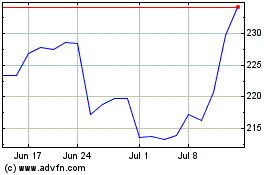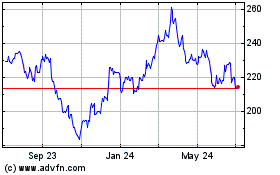Latest Round of Stock Volatility Adds to August Turbulence
August 25 2019 - 9:29AM
Dow Jones News
By Amrith Ramkumar
Stocks enter the final week of August coming off one of their
rockiest stretches of 2019, the latest example of tariff-induced
volatility that has some investors bracing for more
fluctuation.
With the S&P 500's 2.6% drop Friday, the broad equity index
brought its average daily swing above 1% for a third consecutive
week, the longest such streak of the year, according to Dow Jones
Market Data. Stocks averaged a daily move of about 0.5% from
mid-June to early August.
In another sign of investor anxiety, the Cboe Volatility Index,
or VIX, logged a fourth consecutive weekly increase. Wall Street's
"fear gauge" measures expected swings in the S&P 500 and tends
to move inversely to stocks. Commodities including oil and bond
yields have also been volatile, with analysts worried that new
tariffs will further weaken the world economy.
Markets had shown signs of stabilizing before China announced
new tariffs on U.S. imports Friday and President Trump responded by
ordering U.S. companies doing business in China to explore
relocating. The latest developments in the monthslong trade dispute
between the world's two largest economies stoked fresh fears that
an overseas economic slowdown will engulf the U.S. and hurt
consumers.
This week, investors will parse figures on July consumer
spending and another estimate of second-quarter gross domestic
product to gauge whether the U.S. can continue outpacing the rest
of the world. Upbeat July retail sales figures and strong earnings
from companies including Target Corp. and Lowe's Cos. have offered
encouraging signals about the health of the consumer.
Despite recent market swings, some analysts are still hopeful
that lower interest rates and an eventual U.S.-China trade
compromise will improve the outlook for the world economy. While
protectionist trade policies have dented manufacturing activity and
limited business investment, some analysts are confident challenges
to U.S. consumers won't halt spending and economic growth.
"We don't see them actually showing up in the real economy yet,
and for that reason we don't think a recession is imminent," said
Nela Richardson, an investment strategist at Edward Jones, adding
that she expects stocks to perform better than bonds.
At the same time, some analysts fear that the signals from the
bond market and measures of investor confidence could cause more
volatility.
Bond prices, which rise as yields fall, have surged with some
investors seeking safety in Treasurys recently. The movement toward
bonds has pushed longer-term Treasury yields to multiyear lows and
caused one closely watched section of the yield curve, the gap
between two- and 10-year yields, to invert.
Such inversions in which shorter-term yields eclipse longer-term
yields have preceded past recessions, though the timing between
inversions and slowdowns has varied and stocks have often rallied
for months following such a move. One Friday, the 10-year yield
fell below the two-year yield on a closing basis for the first time
since 2007.
Prices for commodities vital to construction and manufacturing
have dropped in August, with investors expecting demand to weaken
alongside economic activity. Copper fell Friday to its lowest level
since May 2017, while a 2.1% decline in oil prices brought crude's
month-to-date decline to 7.5%.
Those moves have prompted traders to increase wagers on lower
interest rates. Federal-funds futures show nearly 90% of investors
expect the Federal Reserve to cut rates at least two more times
this year, CME Group data show. That is up from about 57% a month
ago.
Minutes from the central bank's July meeting published last week
showed officials expected trade uncertainty to continue, though
they were reluctant to say how future adjustments to rate policy
would unfold. Fed Chairman Jerome Powell said early Friday that the
central bank was prepared to provide more stimulus if the
global-growth slowdown spreads to the U.S.
The bets on lower interest rates have pushed some investors
toward shares of companies with more-stable businesses and larger
dividends. The S&P 500 utilities, real-estate and
consumer-staples sectors -- areas typically viewed as safer -- are
the only groups in the index that have risen this month.
Other destinations for safety such as gold outpaced the broader
market on Friday, with the haven metal rising almost 2% to a
six-year high.
Write to Amrith Ramkumar at amrith.ramkumar@wsj.com
(END) Dow Jones Newswires
August 25, 2019 09:14 ET (13:14 GMT)
Copyright (c) 2019 Dow Jones & Company, Inc.
Lowes Companies (NYSE:LOW)
Historical Stock Chart
From Mar 2024 to Apr 2024

Lowes Companies (NYSE:LOW)
Historical Stock Chart
From Apr 2023 to Apr 2024
